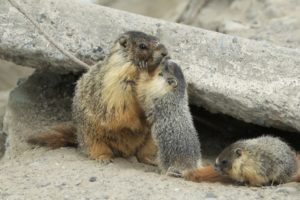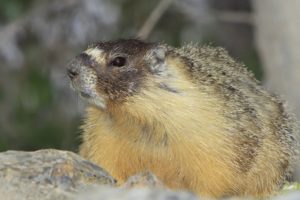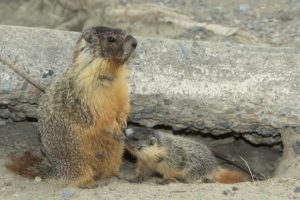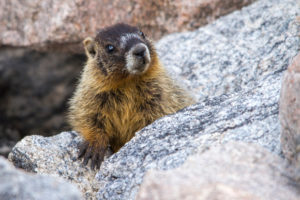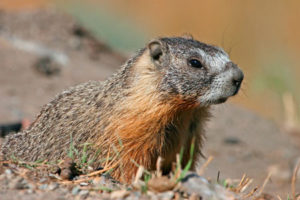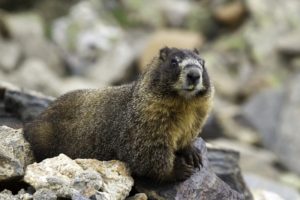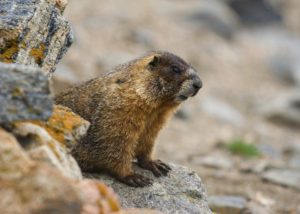Yellow-Bellied Marmot
Yellow-bellied marmot is a species of small- to medium-sized rodents inhabiting the mountainous regions of southwestern Canada and the western United States, including Mount Rainier, Sierra Nevada, and the Rocky Mountains. Found at an elevation of about 6,500 ft, the marmots dig burrows in the ground where they live in colonies.
Scientific Classification
| Kingdom | Animalia |
| Phylum | Chordata |
| Class | Mammalia |
| Order | Rodentia |
| Family | Sciuridae |
| Tribe | Marmotini |
| Genus | Marmota |
| Subgenus | Petromarmota |
| Scientific Name | Marmota flaviventris |
Quick Information
| Other Names | Rock Chuck |
| Size | 47-70 cm |
| Weight | Males: 3-5 kg Females: 1.6-4 kg |
| Color | Brown coat with yellow belly, white patch between the eyes, reddish-brown tail, white muzzle, a black nose |
| Distribution | Alberta, British Columbia (Canada); Colorado, California, Idaho, Nevada, Montana, Oregon, New Mexico, Washington, Wyoming, South Dakota |
| Habitat | Steppes, meadows, valleys, talus fields, other open habitats; sometimes on the edge of coniferous or deciduous forests |
| Sounds /Call | Whistle, scream, tooth chatter |
| Lifespan | 13-15 years |
| Diet | Grass, grains, flowers, leaves, fruit, legumes, grasshoppers |
| Number of Offspring | 3-5 |
| Breeding Season | May – June |
| Gestation Period | Around 1 month |
| Predators | Wolves, foxes, dogs, coyotes, eagles |
| Conservation Status | Least Concern |
Behavior
The diurnal animal stays in colonies comprising 10 to 20 individuals with one alpha male. It spends most of the time in burrows where it hibernates for about eight months, usually occurring from September to May. It gains weight in autumn to attain the threshold limit since 50% of its body weight is lost while hibernating. Although it can climb trees, the animal is mostly terrestrial by nature.
Male marmots are territorial that mark their burrows with secretions from anal glands. They are hostile towards other male yearlings and adults, which is one of the causes of dispersal of yearlings.
Mating and Reproduction
After emerging from hibernation, each male digs burrows and then searches for its mating partner. Males can mate with 2-3 females at the same time. A female can give birth to 3-5 offspring, out of which only half of the pups can survive to maturity.
Life Cycle
Newborn pups weigh about 34 g and measure 110 mm in length. They reach sexual maturity at around two years of age. The female offspring tend to stay in the area near their home while the male offspring leave the area of their birth when they are yearlings and will guard one or more females.
Interesting Facts
- Since the yellow-bellied marmot does not possess excellent eyesight, it uses its exceptional sense of smell and hearing capability to search for food and evade predators.
- It may act as hosts for fleas or tick responsible for transmitting sylvatic plague, or Rocky Mountain spotted fever.
References
Published on March 22nd 2017 by Sajal Datta under Coniferous Forest Animals.
Article was last reviewed on 9th May 2023.



